The Lowdown
Metro Last Light Redux deviated a little bit from the standard “horror” aspect that could be argued should be more present in the post-apocalypse. Still, I’d give this game a recommendation if you like visceral gunplay, getting mauled by giant bats, and, dare I say, a grim setting with a little bit of hope at the end of the tunnel. I repeat, though, do not play this if you have arachnophobia, as it will ruin your day.
Overall
Pros
- The stronger story arc and some truly jaw-dropping moments
- Fun combat and weapon modifications
- Stealth that works well
Cons
- Inconsistent audio and graphics immersion/tone
- Weapon UI is middling at best
Welcome to Part II of my Metro review series, Metro Last Light Redux. Based on a novel series, this Redux is a revamped version of the original Last Light, released in 2013. We join Artyom as he is once again tasked with saving what’s left of the Moscow populace who reside in the subway tunnels post-nuclear apocalypse. For this Metro Last Light Redux review to make sense, there will be some spoilers of the previous game; I recommend you glance at my previous review so you aren’t put out.
I beat this game in 12 hours; here are my thoughts.
What Is F***ed Up This Time? (Spoilers)

If you’ve ever read Life of Pi, you understand what I mean when I say that if you put enough people in a raft, sooner or later, they’re all gonna kill each other. That’s the thesis of Metro Last Light Redux.
When we last saw Artyom, he had climbed a massive tower in the remains of Moscow to set up a targeting laser pointed at the remains of the Botanical Gardens. Your compatriots have taken command of the secret military facility known as D6 after using the nuclear warheads held within to destroy Gardens, as they have become home to new creatures called “Dark Ones.”
Dark Ones, alien-looking mutants able to telepathically turn people’s brains into scrambled eggs, are perceived as the greatest threat to man in this post-apocalyptic reality. In the previous game, Artyom, as a member of a super elite military group called “Rangers,” is dedicated to identifying and eradicating this threat.
Just as you set up the targeting laser, however, it is revealed that the Dark Ones have been simply trying to communicate with what is left of humanity. Their fumbled attempts to connect with the denizens of the metro were disastrous and misinterpreted as an attack.
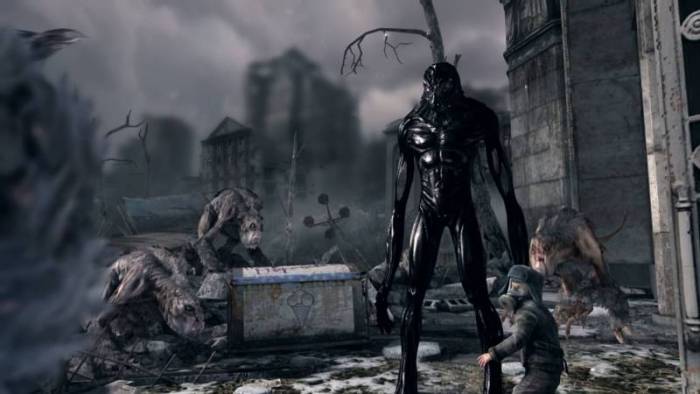
Based on whether you’ve performed enough “moral actions” in this game (sparing enemies, giving money to beggars, listening to people’s complaints), you are able to choose to destroy the targeting blaster and save the Dark Ones rather than letting the missiles fall.
Canonically, however, Artyom chooses not to listen to the Dark Ones and has reduced their home to slag, but life has somehow found a way. There are rumors that a Dark One child has survived and has been spotted wandering around the ruins of Moscow. Artyom, being the little genodicer that he is, is tasked to go find and shoot the kid dead.
Predictably, this goes tits up as you are ambushed by Nazis living in a nearby stronghold, who kidnap both you and the Dark One child.
A soldier from one of the Soviet stations named Pavel teams up with you to facilitate an escape into the tunnels. Artyom is eager to resume his hunt, but Pavel has other plans. In the background, the larger Metro community has gotten wind of D6 and the treasure trove of resources held within. Each faction has its eye cast onto the veritable fortress and will do whatever it takes to acquire it.
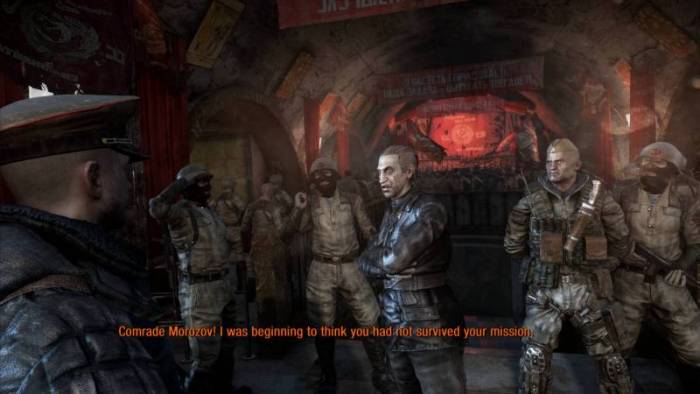
Fueled by this agenda, the Soviets (Reds) detain Artyom and interrogate him about D6 and the Dark Ones. Once again, you manage to escape and find that through a double agent within D6, the Reds have not only managed to acquire the Dark One but have also released a pathogen taken from the facility onto an innocent and unsuspecting station.
Their plan is to gaslight the rest of the Metro community that the Rangers are unfit to hold D6 due to the release of this deadly sickness and that the bunker’s wealth should be shared for everyone’s safety; a summit is called at a neutral site so that this can be discussed.
Artyom eventually finds the little Dark One, but in a continuation from the previous game, he is seemingly one of the sole humans able to communicate with the creature.
This is due to the fact that many years ago, Artyom as a child, actually opened up a door to the surface and was saved from being eaten by the Dark One community, leading to a bond that has carried through time.
Pity he killed them all, though.
Interacting with the mutant via telepathy, Artyom is given the opportunity to learn more about this alien culture as well as teach the child empathy. As mentioned, the moral point system from the previous game is still present, so choosing not to kill someone or choosing to do an honorable action influences which ending you will receive and how the child reacts.
As a whole, Metro Last Light Redux deals a lot more with the intricacies of human politics/scheming as opposed to surviving a hostile world. I, for one, enjoyed this a lot more than the previous game’s storyline. It is vastly more interesting to deal with this level of subterfuge and clearly evil entities, as opposed to rabid mutants.
At the end of the day, the mutants are just animals on steroids, so you can’t really fault them for trying to eat you, but in this game, your enemies are clearly making a choice to be pricks. This provides a stronger moral compass to the player and subsequently moves the story along more successfully.

In terms of story progression, another clear improvement from this game over Metro 2033 Redux is that there were clear “clench ye arsecheeks” moments that served as bookmarks for me between story arcs.
The first game seemed to blur together a little, with it being a very flat line in terms of story. Metro Last Light Redux has clear peaks and valleys between the action, culminating towards a massive climax in the end.
These smaller yet noticeable peaks made you feel you were surpassing obstacles, as opposed to some guy with a gun trying his best not to get eaten.
For example, an earlier mission has you escaping a Metro station through a series of tunnels with many inhabitants, foreshadowing it is housing something big.
As you fend off the critters dwelling within, a monstrous unit of a mutant drops down in front of you. After what felt like 10 grenades and half my ammunition across all weapons on me, the thing lay dead. This unique enemy clearly served as a demarcation point between story acts, and I, for one, appreciated this structure.
Basically, by providing you with milestones in the narrative and combat, it seems like tangible progress is being made.
Metro Last Light Redux improved the atmosphere of the first game. From the dank tunnels to the bleak surface to the boisterous theatre within a station, each biome felt more distinctive. A key example is that in the previous game, all the Metro stations, by and large, looked remarkably similar.
Sure, the Nazis had swastikas while the Reds had the Hammer and Sickle, but besides these little decorative features, everything looked just as shitty as the next.
In Last Light, you could really get a feel as to how the inhabitants of each human settlement lived and, subsequently, what the “local culture” was like.
I thought that this was an appreciable improvement and welcomed these little vignettes into post-apocalyptic Russian life.
Shooting, Sneaking, and Silencers
Metro Last Light Redux didn’t revamp the combat formula too drastically. For record-keeping purposes, I played this game on the Spartan mode setting, which favors a more “action-oriented” game as opposed to a stealthy one.

Take that, scum!
Your classic weapons from the previous game have returned, like the ever-reliable AK rifle and the absolute dogshit Bastard gun, so return gamers will be able to step right into the action. You are able to hold three guns at a time, and in most cases, you will be scrounging up ammunition from corpses and the environment at large.
Automatic rifle bullets come in two forms, regular and military-grade rounds. Just like the first game, MGRs are your currency that can be used to acquire weapons and supplies at settlements. However, they can also be used in combat and supply a sizeable damage boost. It’s entirely up to the player as to whether they’d like to use their money as legal tender or as high-velocity ordinance.
Your secondary weapons likewise remain largely untouched. Throwing knives are still ridiculously powerful, and your assortment of grenades can take down fortified or bulkier targets with relative ease. My personal favorites were the sticky bombs that I attached to many a mutant in an attempt to save Artyom from getting mulched. They did add a claymore mine that is proximity triggered, so have fun setting traps if that’s your style.
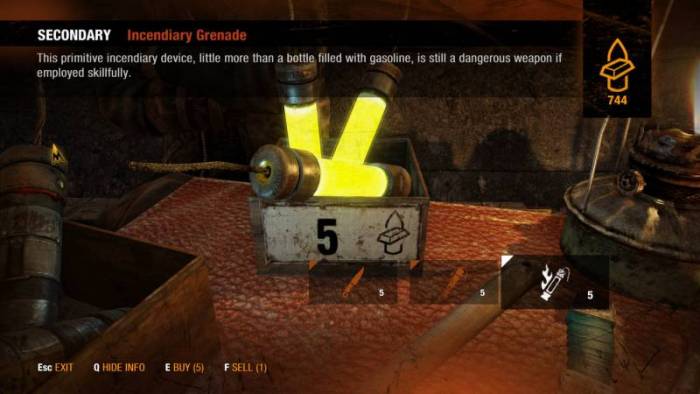
What made me smile is that the charming division of pneumatic weapons returns. As a refresher, these are weapons that use pressure to send ball bearings or crossbow bolts careening through the skulls of whatever is in front of you. They retain the ability to eliminate targets silently, and with a maximum amount of pressure, it’s pretty much a one-hit kill against humans.
You will be fighting a lot more humans than you’d expect, so keep that in mind while customizing load-outs.
There isn’t anything radically that different, so if you would like to learn more and haven’t read it already, click on the link to my previous review at the top of the article. The comments I made about gunplay in that article can roughly transfer to this game as well.
There was some innovation on the stealthier side of things, however.
Many of the Metro Last Light Redux maps have designated routes that take you well out of the line of sight of most enemies. Be this vents under the floor, elevated walkways, or simply corridors that circumvent sentries, stealth as a concept seemed much more attainable this time around.
Even with a full squad of soldiers or a pack of mutants hanging around, observing the environment, more often than not, revealed a path that would deliver you to safety without firing a shot.

In addition to map layout, Artyom is now able to snuff out light sources, and while that may seem inconsequential, this is the gameplay equivalent of discovering the cure for scurvy. Enemy awareness is heavily tied to ambient illumination, so with a properly silenced weapon and judiciously turning off light bulbs or circuit breakers, you can create your own advantage.
I’m always for increasing player control and tactical range, so this was a welcome addition. In the previous game, I sometimes felt like I was at the mercy of the map as opposed to being able to exert my will on the situation. Perhaps this is also related to Artyom being a spec-ops soldier in this title, but regardless, it was much better this time around.
Continuing the theme of versatility, weapon mods make a return, and like the preceding game, they really open up a bevy of tactical options for you. They’re typically concentrated within the larger categories of scopes, silencers, and magazine size. Silencers are an invaluable addition because the drop-off in damage is negligible when you consider how nice it is not to be shot at from all sides.

All in all, there wasn’t a total overhaul in terms of the combat/exploration mechanics, but the small additions they did make here and there were great and thoroughly improved the experience.
Who We Shooting At?
There were a few noticeable changes in the enemy roster, but the rule of thumb remains the same: mutants are still bullet sponges, and humans are not. Humans have guns, mutants do not. Plan accordingly.

As mentioned, the story has you crawling around human encampments a decent bit, so it makes sense that you’ll be fighting more humanoid enemies than in the previous game. The firepower they possess will vary, and some come equipped with crude metal body armor that takes a few more shots to break through.
By and large, the strategy is the same. Aim for the head and be accurate.
You will find that in the sequel, human enemies have a modicum more brain matter than previously. They’ll take cover sometimes, attempt to flank occasionally, and just generally won’t present themselves as huge targets. Small improvement for sure, and it increased the immersion.
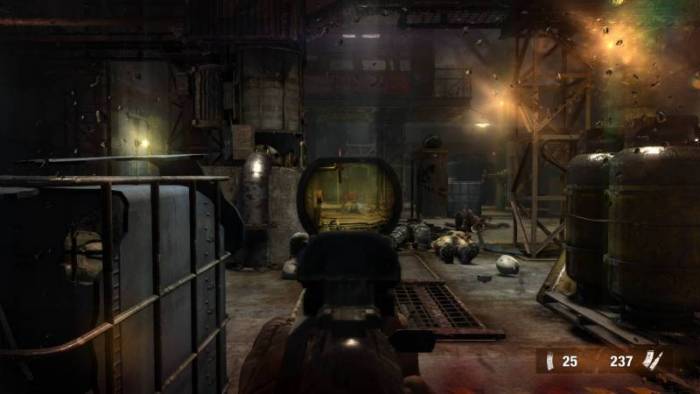
Now, as always, mutants are where things get a little screwy.
As a refresher, radiation has turned a lot of mammals into engines of destruction. Even the lowly mole has turned into a walking tornado of teeth called a Nosalis, and just one of these can end Artyom’s day. Even the weakest mutant is very tough and will absorb plenty of bullets unless you queue up a perfect headshot.
This is exceedingly difficult due to the speed at which these things move, so it is advised that you pack a shotgun whenever you feel you may be encountering a Noah’s Ark reject. My two “favourites” make a triumphant return to the field, the aforementioned Nosalies and the flying Demons, so it’s good that the development team decided to commit themselves to give me a headache.
Funnily enough, as much as I hate the Nosalies, they aren’t actually the worst critters in the game to fight. Sure, they’re ugly and voracious, but manageable. Metro Last Light Redux has decided to up the ante in creepy by introducing you to mutated shrimps….and spiders.
Shrimps are large silk worm-looking things that are amphibious. They’ll ambush you from murky water just about any chance they get. They possess an acid spit of sorts, and after killing maybe 60 or so, I am still not entirely sure where their weak spot is. Logic would assume their underbelly, but I never noticed it taking fewer shots to drop them if I aimed at that section of their body.
It’s possible that in my sheer panic, I missed, so take my assessment with a grain of salt.
The “spiders” are just simply horrific. It is actually my recommendation that you refrain from playing this game if you have an aversion to them in real life because let me tell you, they’re nightmare-fuel in Metro Last Light. They are unavoidable from a narrative perspective, and you will need to deal with them to progress through the main story.
Their unique trick is that in addition to having really offputting sound effects when they skitter at you, they are also completely bulletproof under normal circumstances. Yes. You read that correctly; completely bulletproof. This is in addition to being able to climb up walls, ambush you out of holes, and there being a lot of them in a very dark and cramped environment.
The trick with them is to use your flashlight or another light source to force them to flip belly up temporarily so that you can unload your clip into their stomach. Fine and dandy, but they run away from your flashlight and need to remain in the beam for a few seconds to expose their weakness.
Chasing one spider around a corner isn’t great because there are always more of them, and your back is a very juicy target.
It’s stressful.
If I had to sum up the enemy contingent of Metro Last Light Redux, I’d say the diversity is awesome. The game shunts you along at a decent pace and doesn’t force you to fight the same type of enemy for too long, meaning shit will not get stale.
In the first game, there were definitely missions I dreaded just due to the fact I knew I’d have to fight the same type of animal over and over again—another noticeable improvement.
Metro Last Light Redux Criticisms
Despite all the positives, there were a few matters in which I felt the game could have been better.
The graphics and ambiance outside of a few select instances didn’t strike me as immersive as the previous game. A lot of elements felt a little too sanitized and clean, especially when it came to character models.
While they didn’t look objectively bad, I still felt that it didn’t quite uphold the “Metro spirit” I was expecting. It seemed almost cartoony at times.

Waddaya looking at?
Likewise, audio mixing was hit or miss. Guns sounded really good, and so did mutant growls, but the rest kind of stumbled over each other. For example, the ambient dialogue seemed to just be inserted into the environment as an overlay as opposed to being natural. Artyom, being a silent protagonist and constantly being talked at, also made this particular experience feel artificial.
Juxtaposed against some truly awesome moments, these audio and visual nitpicks were especially jarring. I remember a scene where Artyom is walking through a tunnel comprised of the corpses of those atomized by the nuclear holocaust. This is clearly a hallucination, but that scene is truly a masterpiece in terms of impressing upon the player the magnitude of what is happening. I would’ve liked more of that.

The restless dead
The inventory UI is still a travesty as well. Swapping between secondary weapons is done by opening the inventory system and moving your mouse in a certain direction to select a corresponding grenade or knife.
It frankly sucks.
It’s clunky, slow, and, half the time, doesn’t hit the right thing. It’s marginally better than Metro 2033, but it made me not want to use other weaponry other than the one I had selected at the time. Thankfully, I’m really good at aiming throwing knives.
This version of the game has extra missions that allow you to take part in small storylines and challenges. In the Dungeons and Dragons world, we call these “one-shots.” For example, in one, you get to play a main game mission through the eyes of a secondary protagonist instead of Artyom.
I didn’t feel they added anything super exciting, so I honestly did a few and then called it quits. It didn’t add enough to the experience other than, “oh, here’s some extra shit.”
Conclusion
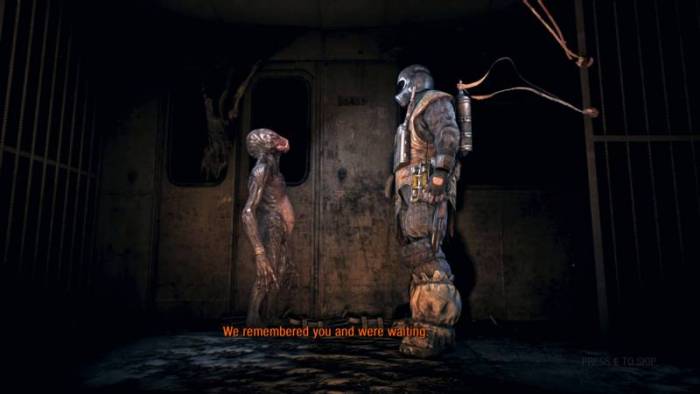
Yeah, this is a shorter review, but we need a little variety in our lives. Metro Last Light Redux does a lot of things well and, in my opinion, improves on the framework of its predecessor. It definitely has limitations, but it’s a really good experience that is often on sale for very cheap (on Steam, at least).
Metro Last Light Redux deviated a little bit from the standard “horror” aspect that could be argued should be more present in the post-apocalypse. Still, I’d give this game a recommendation if you like visceral gunplay, getting mauled by giant bats, and, dare I say, a grim setting with a little bit of hope at the end of the tunnel. I repeat, though, do not play this if you have arachnophobia, as it will ruin your day.
Metro Last Light Redux sells for $19.99; it is available from Steam, gog.com, GameStop, Epic, and other retailers.
Developer: 4A Games
Publisher: Deep Silver
Source: Personal Purchase
What I Like: The stronger story arc and some truly jaw-dropping moments; Fun combat and weapon modifications; Stealth that works well
What Needs Improvement: Inconsistent audio and graphics immersion/tone; Weapon UI is middling at best
